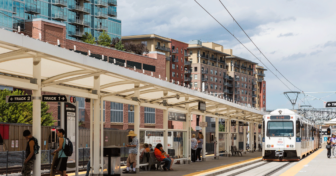If there is one issue that both Michigan candidates for governor seem to agree on it is that fixing the roads is a top priority. Good news in a state that for a decade or more let its ![]() 20th Century infrastructure crumble. But saying you are in favor of fixing the roads is not enough.
20th Century infrastructure crumble. But saying you are in favor of fixing the roads is not enough.
First we need to know how they are going to pay to fix the roads. We need to shift from an economic strategy based on low taxes to one that recognizes taxes must be balanced with the need for public investments.
We need to regain the political will we had for most of the 20th Century when we set user fees at the level required to have one of the nation’s best transportation systems. We understood that what we got from user fees was worth more than the cost of the fees. Michigan is now a national laggard in road funding. As it has historically been in public transportation funding.
Minnesota, the Great Lakes most prosperous state, spends per capita more than twice Michigan on transportation.
Second just fixing the roads is not enough. It is clear that autonomous vehicles are coming. It is a question of when, not if. And that means radical change in the industry that drives Michigan’s economy; in how we live our lives; and how our communities are structured.
We need to shift from accepting a crumbling 20th century infrastructure to providing a world-class 21st century transportation infrastructure. Where world-class 21st Century infrastructure means complete streets––designed for all modalities and for everyone––not just good roads. And is aligned with the transition to autonomous vehicles and mobility as a service. A world in which, almost certainly, fewer and fewer of us will own and/or drive a car as the primary way to get around
Jim Hackett, President and CEO, Ford Motor Company clearly understands that Ford’s future is in transitioning from making vehicles to providing mobility services. In Building the City of Tomorrow he writes:
Henry Ford once declared that he wanted to open the highways for all humankind, giving us extraordinary new freedom. Yet as our towns and cities were designed around the automobile, roads overtook community centers. Time we used to spend with each other is now often wasted in congestion and traffic. Thirty years ago, we spent an average of 16 hours in traffic per year; now, it’s 38 hours.
Today, the transport systems of most global cities have reached capacity, yet more and more of us seek the benefits of great urban centers. Faced with this rapid urbanization, and the pollution and congestion that come with it, we have to admit that the model of the past is no longer tenable. We need to update cities to more efficiently move people and goods, improving the quality of life for all.
Now is our opportunity to reclaim the streets for living: to start building a true City of Tomorrow, reimagining how our streets and cities function more efficiently. With the power of artificial intelligence (AI) and the rise of autonomous and connected vehicles, we have technology capable of a complete disruption and redesign of the surface transportation system for the first time in a century. Everything from parking, traffic flow and goods delivery can be radically improved–– reducing congestion and allowing cities to transform roads into more public spaces.
Across the globe communities are investing heavily in creating 21st Century transportation systems. An Economic Times article details the highly automated airport of the future being built in Singapore. The video in the article is really worth watching.
In a City Lab article entitled The Global Mass Transit Revolution Richard Florida writes: “Transit is a key component of modern urban infrastructure. It contributes to the density and clustering that drive innovation and productivity, extends the boundaries of cities’ metro areas while creating opportunities for denser development around suburban stops, and makes for less-stressful commutes. While most of the rest of the world, especially rapidly urbanizing centers in Asia, is investing heavily in transit, the U.S. lags far behind.”
As these articles document the U.S. is a laggard in investing in 21st Century transportation. And Michigan is a laggard within the U.S. This needs to change.
Microsoft co-founder Paul Allen’s Vulcan is an investor along with USDOT in the Transportation Smart City Challenge. Vulcan writes of Columbus, Ohio’s winning proposal: “Columbus will work to reshape its transportation system to become part of a fully-integrated city that harnesses the power and potential of data, technology, and creativity to reimagine how people and goods move throughout their city.”
This same kind of thinking is what Michigan needs from its next governor. A commitment to Michigan being ahead of the curve in the transition from making vehicles to providing mobility services for all.
So the policy priority for Michigan is not more money to simply rebuild its current transportation system, it is to find the political will to do what we did for most of the last century: be a global leader in building the transportation system of the future.







